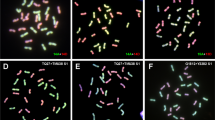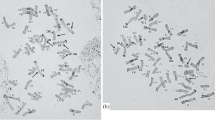Summary
F1 hybrids with the genome constitution ABDERR (2n = 6x = 42) or ABDE(AB)RR (2n = 7x = 49), selected from crosses between either an octoploid Triticum aestivum/Thinopyrum elongatun amphiploid and tetraploid Secale cereale (AABBDDEE x RRRR) or autoallohexaploid triticale [AABBDDEE x (AB)(AB)RRRR], were backcrossed to tetraploid triticale (AB)(AB)RR and selfed for six generations. Thirty-three different tetraploid F6 progenies were karyotyped using C-banding. The aneuploidy frequency was 6.6% with 4.0% hypoploids and 2.6% hyperploids. Among 71 plants with 28 chromosomes, 53.5% had a stabilized karyotype while 46.5% were unstabilized with at least one homoeologous group segregating for A-, B-, or D-genome chromosomes. The stabilized plants represent 19 different tetraploid karyotypes with six of them not containing any detectable D-genome chromosomes from T. aestivum or E-genome chromosome from Th. elongatum. Thirteen lines were (ABD)(ABD)RR tetraploids with one-to-three disomic substitutions of D-genome chromosomes for A or B-genome chromosomes. No disomic substitution of E-genome chromosomes was identified. On average 0.58 D substitutions per line were determined. Of the seven D-genome chromosomes only four, 1D, 2D, 5D, and 7D, were present in their disomic state. In unstabilized karyotypes, chromosomes 3D, 4D, and 6D were present in their monosomic state. Among all 30 viable plants (42.3%), the order of decreasing frequency of Dgenome chromosomes was 5D (25.0%), 1D (20.0%), 2D (10.0%), 6D (5.0%), and 3D (1.7%). Plants with 4D and 7D chromosomes were not viable. An increase in the number of D-genome chromosomes in the (ABD) genome is associated with a decrease in viability and fertility. Minor differences in the C-banding of chromosomes in homoeologous groups 1, 5, and 6 indicate the possibility of translocations between A-, B-, D-, and E-genome chromosomes. Evolutionary and breeding aspects of tetraploid triticale with mixed genomes are discussed.
Similar content being viewed by others
References
Badaev NS, Badaeva ED, Dubovets NI, Bolsheva NL, Bormotov VE, Zelenin AV (1992) Formation of a synthetic karyotype of tetraploid triticale. Genome 35:311–317
Baum M, Lelley T (1988) A new method to produce 4 x triticales and their application in studying the development of a new polyploid plant. Plant Breed 100:260–267
Driscoll CJ (1973) Minor genes affecting homoeologous pairing in hybrids between wheat and related genera. Genetics 74:566
Dvorák J (1987) Chromosomal distribution of genes in diploid Elytrigia elongata that promote or suppress pairing of wheat homoeologous chromosomes. Genome 29:34–40
Dvorák J, McGuire PE (1981) Nonstructural chromosome differentiation among wheat cultivars, with special reference to differentiation of chromosomes in related species. Genetics 97:391–414
Endo TR, Gill BS (1984) The heterochromatin distribution and genome evolution in diploid species of Elymus and Agropyron. Can J Genet Cytol 26:669–678
Feldman M (1966) The effect of chromosomes 5B, 5D and 5A on chromosomal pairing in Triticum aestivum. Proc Natl Acad Sci USA 55:1447–1453
Gill BS, Chen PD (1987) Role of cytoplasm-specific introgression in the evolution of polyploid wheats. Proc Natl Acad Sci USA 84:6800–6804
Gill BS, Friebe B, Endo TR (1991) Standard karyotype and nomenclature system for description of chromosome bands and structural aberrations in wheat (Triticum aestivum). Genome 34:830–839
Gregory RW, Webb PJ, Hampson PR, Kempton RA (1986) Plant breeders' rights for triticale: are the uniformity standards detrimental to agronomic performance. In: Proc Int Triticale Symp, Sydney, Australia, pp 22–30
Gustafson JP (1976) The evolutionary development of triticale: the wheat-rye hybrid. In: Hecht MK, Steere WC, Wallace B (eds) Evolutionary biolog, vol 9. Plenum Press, New York, pp 107–135
Gustafson JP, Krolow KD (1978) A tentative identification of chromosomes present in tetraploid triticale based on heterochromatic banding pattern. Can J Genet Cytol 20:199–204
Hohmann U (1985) Cytology and fertility of primary and secondary tetraploid triticale and advanced populations. In: Bernard M, Bernard S (eds) Genetics and breeding of triticale. INRA, Paris, pp 267–275
Hohmann U (1988) Direct use of hexaploid wheat in the production of recombined hexaploid triticale. In: Miller TC, Koebner RMD (eds) Proc 7th Int Wheat Genet Symp, Cambridge, England, pp 303–308
Hohmann U, Krolow KD (1991) Introduction of D-genome chromosomes from Aegilops squarrosa L. into tetraploid triticale (AB)(AB)RR (2n = 28). Theor Appl Genet 82:777–783
Kota RS, Dvorák J (1986) Mapping of a chromosome pairing gene and 5s rRNA genes in Triticum aestivum L. by a spontaneous deletion in chromosome arm 5Bp. Can J Genet Cytol 28:266–271
Krolow KD (1973) 4x-triticale, production and use in triticale breeding. In: Sears ER, Sears LMS (eds) Proc 4th Int Wheat Genet Symp, Columbia, Missouri, pp 237–243
Krolow KD (1974) Research work on 4x-triticale in Germany (Berlin): In: MacIntyre R, Campbell M (eds) Proc Triticale, El Batan, Mexico. Int Dev Res Centre Monogr IDRC-024e, Ottawa, pp 51–60
KrolowKD (dy1983) New aspects for the use of 4x-triticale (2n = 28) in triticale development. In: Sakamoto S (ed) Proc 6th Int Wheat Genet Symp, Kyoto, Japan, pp 903–907
Krolow KD, Lukaszewski AJ (1986) Tetraploid triticale — a tool in hexaploid triticale breeding. In: Horn W, Jensen CJ, Odenbach W, Schieder O (eds) Proc Genet Manip in Plant Breed. Walter de Gruyter and Co., Berlin, pp 105–117
Krolow KD, Lukaszewski AJ, Gustafson JP (1985) Preliminary results on the incorporation of D- and E-genome chromosomes into 4x-triticale. In: Bernard M, Bernard S (eds) Genetics and breeding of triticale. INRA, Paris, pp 289–295
Lehmann C, Hohmann U, Krolow KD (1991) Tetraploid triticale with D-genome chromosomes of Triticum aestivum produced with autoallohexaploid triticale. Cer Res Comm 19:469–476
Liu CJ, Atkinson MD, Chinoy CN, Devos KM, Gale MD (1992) Nonhomoeologous translocations between group 4, 5 and 7 chromosomes within wheat and rye. Theor Appl Genet 83:305–312
Lukaszewski AJ, Gustafson JP (1983) Translocations and modifications of chromosomes in triticale-wheat hybrids. Theor Appl Genet 64:239–248
Lukaszewski AJ, Gustafson JP (1987) Cytogenetics of triticale. In: Janick J (ed) Plant breeding reviews, vol 5. Van Nostrand Reinhold Company, New York, pp 41–93
Lukaszewski AJ, Apolinarska B, Gustafson JP, Krolow KD (1984) Chromosome constitution of tetraploid triticale. Z Pflanzenzücht 93:222–236
Lukaszewski AJ, Apolinarska B, Gustafson JP (1987 a) Introduction of D-genome chromosomes from bread wheat into hexaploid triticale with a complete rye genome. Genome 29:425–430
Lukaszewski AJ, Apolinarska B, Gustafson JP, Krolow KD (1987 b) Chromosome pairing and aneuploidy in tetraploid triticale. 1. Stabilized karyotypes. Genome 29:554–561
Lukaszewski AJ, Apolinarska B, Gustfson JP, Krolow KD (1987 c) Chromosome pairing and aneuploidy in tetraploid triticale. 2. Unstabilized karyotypes. Genome 29:562–569
Miller TE, Reader SM (1985) The effect of increased dosage of wheat chromosomes on chromosome pairing and an analysis of the chiasma frequencies of individual wheat bivalents. Can J Genet Cytol 27:421–425
Naranjo T, Toca A, Goicoechea PG, Giraldez R (1987) Arm homoeology of wheat and rye chromosomes. In: Miller TC, Koebner RMD (eds) Proc 7th Int Wheat Genet Symp, Cambridge, England, pp 115–120
Sears ER (1954) The aneuploids of common wheat. Res Bull Univ Mo Agric Exp Stn 572:1–59
Viegas WS, Mello-Sampayo T, Feldman M, Avivi L (1980) Reduction of chromosome pairing by a spontaneous mutation on chromosomal arm 5DL of Triticum aestivum. Can J Genet Cytol 22:569–575
Vos DJ (1983) Introgression of material from Agropyron elongatum (2n = 14) into triticale. In: Sakamoto S (ed) Proc 6th Int Wheat Genet Symp, Kyoto, Japan, pp 897–902
Zohary D, Feldman M (1962) Hybridization between amphiploids and the evolution of polyploids in the wheat (Aegilops-Triticum) group. Evolution 16:44–61
Author information
Authors and Affiliations
Additional information
Communicated by G.S. Khush
Rights and permissions
About this article
Cite this article
Hohmann, U. Stabilization of tetraploid triticale with chromosomes from Triticum aestivum (ABD)(ABD)RR (2n = 28). Theoret. Appl. Genetics 86, 356–364 (1993). https://doi.org/10.1007/BF00222102
Received:
Accepted:
Issue Date:
DOI: https://doi.org/10.1007/BF00222102




